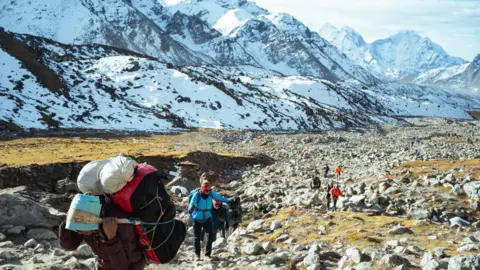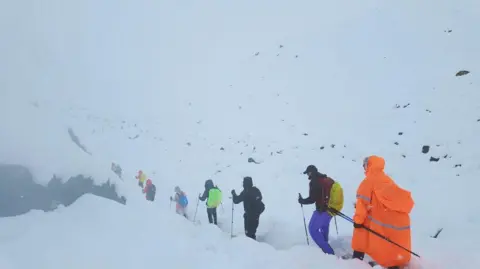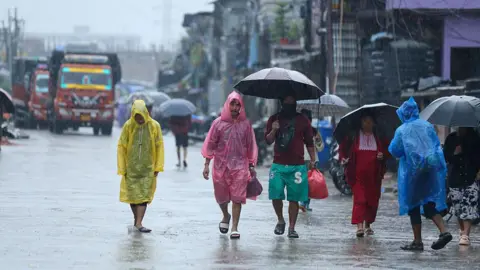Navin Singh KhadkaEnvironment correspondent, BBC World Service
 Getty Images
Getty ImagesClear skies, calm winds and a panoramic view of Himalayan peaks draped in snow – that is the autumn hikers on Mount Everest have come to love.
But that seems to be changing.
Meteorologists say monsoon now stretches into autumn, which is traditionally mountain tourism season. And during this delayed tail end of monsoon, they have recorded at least one episode of extreme rainfall almost every year for the past decade, with mountain weather becoming dangerous.
Last weekend, a shock blizzard stranded hundreds of tourists near the eastern face of Everest for days in freezing temperatures at an altitude of more than 4,900m (16,000ft).
Nearly 600 trekkers were guided to safety by the end of Tuesday, Chinese state media said. One person had died from hypothermia and altitude sickness, but the others were reportedly in good condition.
This was on the Tibetan side but something similar had unfolded on the Nepal side, where a South Korean mountaineer died on Mera Peak.
The world found out much later because communication lines were hit by torrential rains and heavy snowfall. Officials estimate that landslides and flash floods in the country have killed around 60 people over the past week.
This is highly unusual for October “when we expect the skies to remain clear,” said Riten Jangbu Sherpa, a mountain guide, adding that trekkers have been increasingly caught in unexpected extreme weather in recent years.
Given this is the favoured season, frequent storms like this have “hampered our trekking and mountaineering business,” he added.
The monsoon season in northern India and Nepal usually lasts from June to mid- September, but not anymore.
“Our data shows that most of the years in the past decade have had monsoons lasting until the second week of October, which is definitely a change,” said Archana Shrestha, deputy director general at Nepal’s department of hydrology and meteorology.
More worrying is the heavy rain and snow the tail end of the season brings, like it did this time on 4 and 5 October – Ms Shreshtha described the pattern as “damaging precipitation in a short span of time”.
High in the Himalayas, such extreme weather means blizzards and snowstorms, which is a huge risk for trekking, mountaineering and tourism.
 Reuters
ReutersThat’s what happened last weekend when the weather changed quite suddenly – the winds began howling, temperatures plummeted and visibility dropped drastically.
The road that had comfortably brought the hikers to what should have been a stunning pitstop was now buried in snow and impossible to traverse.
On Cho Oyu, another mountain which stands between China and Nepal, a team of climbers on the 8,201m peak retreated temporarily as snow fell unabated.
“Now they are back after the heavy snowfall ended,” said expedition operator Mingma Sherpa, whose team has six members.
But for hikers trapped near the eastern face of Everest, the return was much dicier. Some told the BBC they battled hypothermia despite being dressed warmly while trudging along deep snow. Others said they didn’t sleep for fear of being buried in the snow, which was falling so heavily that they spent most of their time clearing it.
It could have ended in tragically had it not been for a well-coordinated rescue, with yaks and horses deployed to clear the snow.
Still, one trekker, who had hiked up these mountains more than a dozen times, told the BBC he had “never experienced weather like this”.
One big driver is the higher amount of moisture in the air because of how the world has been warming, scientists say.
That has led to torrential rains over a short span of time, often after a prolonged dry spell – unlike in the past when monsoon showers were spread evenly over four months.
“The weather at this time of the year has been changing every year in recent years, we can’t promise our clients anything,” said Passang, a travel agent in the Tibetan capital Lhasa.
“September, October used to be peak season with pleasant weather but these days we see extreme weather all of a sudden and the temperature drops so quickly.”
 Getty Images
Getty ImagesA turbocharged monsoon
Weather experts say the monsoons in South Asia at times appear to have become stronger because they are increasingly coming into contact with another weather system, the westerly disturbance.
This is a low pressure system that originates in the Mediterranean region and travels east – it carries cold air that brings rains and occasionally snow to northern India, Pakistan and Nepal.
But when it meets air that is warmer and wetter – which is what happens during the monsoon – the result can lead to more extreme weather.
Put simply, westerly disturbances can “effectively turbocharge the monsoon”, said Akshay Deoras, a weather scientist at the University of Reading in the UK.
The reason this is happening more often is that these weather systems have traditionally been a winter phenomenon, arriving between December and March in northern India and the Himalayas.
But now, meteorologists say, they are frequently arriving earlier, during monsoon and autumn.
The deluge of rain and snow in eastern Nepal, where Everest is located, in early October was also because of the westerly disturbance, officials at Nepal’s meteorology department said.
They added that the westerly disturbance had fuelled a low-pressure system (a part of the tail end of monsoon) from the Bay of Bengal, pushing the clouds eastwards when in fact they should have moved west.
Scientists have also found that in a warming world, the growing interaction between westerly disturbances and monsoons is producing another unusual result.
The warmer air is pushing the clouds higher, which means these weather systems are now able to cross the Himalayas and reach Tibet and other areas that did not see so much rain before.
A study published in the journal Nature in June notes that “the warming climate and the interaction between the westerly and the Indian monsoon are making the Qinghai-Tibet Plateau change into a warming and wetting climate”.
The Tibetan plateau has always been home to a dry climate. And scientists say a warm, wet Tibet could mean unstable weather and frequent snowstorms and blizzards.
“What’s changed is the reliability of patterns; we can’t assume that conditions will behave the same from season to season,” said Logan Talbott, chief guide with Alpenglow Expeditions that brings climbers to the Tibet side of Everest each year.
“That means flexible scheduling, real-time decision-making, and experienced leadership [in the Himalayas] have become even more important.”



